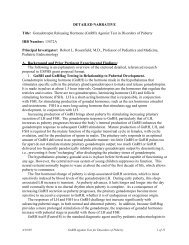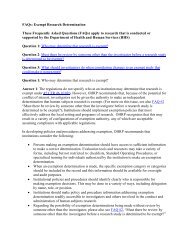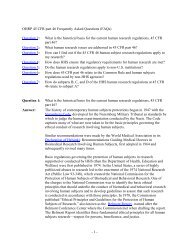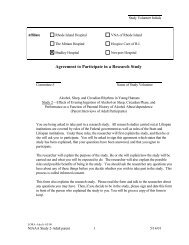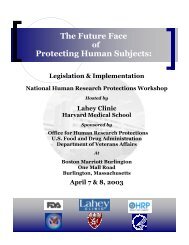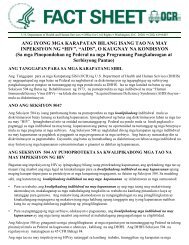VIROPTIC Ophthalmic Solution, 1% Sterile - HHS Archive
VIROPTIC Ophthalmic Solution, 1% Sterile - HHS Archive
VIROPTIC Ophthalmic Solution, 1% Sterile - HHS Archive
You also want an ePaper? Increase the reach of your titles
YUMPU automatically turns print PDFs into web optimized ePapers that Google loves.
Systemic absorption of trifluridine following therapeutic dosing with <strong>VIROPTIC</strong> appears to be <br />
negligible. No detectable concentrations of trifluridine or 5-carboxy-2'-deoxyuridine were found <br />
in the sera of adult healthy normal subjects who had <strong>VIROPTIC</strong> instilled into their eyes seven <br />
times daily for 14 consecutive days. <br />
Clinical Studies: During a controlled multicenter clinical trial, 92 of 97 (95%) patients (78 of <br />
81 with dendritic and 14 of 16 with geographic ulcers) responded to therapy with <strong>VIROPTIC</strong> as <br />
evidenced by complete corneal re-epithelialization within the 14-day therapy period. Fifty-six of <br />
75 (75%) patients (49 of 58 with dendritic and 7 of 17 with geographic ulcers) responded to <br />
idoxuridine therapy. The mean time to corneal re-epithelialization for dendritic ulcers (6 days) <br />
and geographic ulcers (7 days) was similar for both therapies. <br />
In other clinical studies, <strong>VIROPTIC</strong> was evaluated in the treatment of herpes simplex virus <br />
keratitis in patients who were unresponsive or intolerant to the topical administration of <br />
idoxuridine or vidarabine. <strong>VIROPTIC</strong> was effective in 138 of 150 (92%) patients (109 of 114 <br />
with dendritic and 29 of 36 with geographic ulcers) as evidenced by corneal re-epithelialization. <br />
The mean time to corneal re-epithelialization was 6 days for patients with dendritic ulcers and 12 <br />
days for patients with geographic ulcers. <br />
The clinical efficacy of <strong>VIROPTIC</strong> in the treatment of stromal keratitis and uveitis due to herpes <br />
simplex virus or ophthalmic infections caused by vacciniavirus and adenovirus has not been <br />
established by well-controlled clinical trials. <strong>VIROPTIC</strong> has not been shown to be effective in <br />
the prophylaxis of herpes simplex virus keratoconjunctivitis and epithelial keratitis by<br />
well-controlled clinical trials. <strong>VIROPTIC</strong> is not effective against bacterial, fungal, or chlamydial <br />
infections of the cornea or nonviral trophic lesions. <br />
INDICATIONS AND USAGE: <strong>VIROPTIC</strong> <strong>Ophthalmic</strong> <strong>Solution</strong>, <strong>1%</strong> (trifluridine ophthalmic <br />
solution) is indicated for the treatment of primary keratoconjunctivitis and recurrent epithelial <br />
keratitis due to herpes simplex virus, types 1 and 2. <br />
CONTRAINDICATIONS: <strong>VIROPTIC</strong> <strong>Ophthalmic</strong> <strong>Solution</strong>, <strong>1%</strong> is contraindicated for patients <br />
who develop hypersensitivity reactions or chemical intolerance to trifluridine. <br />
WARNINGS: The recommended dosage and frequency of administration should not be <br />
exceeded (see DOSAGE AND ADMINISTRATION). <br />
PRECAUTIONS: <br />
General: <strong>VIROPTIC</strong> <strong>Ophthalmic</strong> <strong>Solution</strong>, <strong>1%</strong> should be prescribed only for patients who have <br />
a clinical diagnosis of herpetic keratitis. <br />
<strong>VIROPTIC</strong> may cause mild local irritation of the conjunctiva and cornea when instilled, but <br />
these effects are usually transient.





